Saba - island in the Caribbean, part of the Netherlands
Saba, known as "the Unspoiled Queen" due to the protection of its unique ecosystem, is a 13-km² (5 sq mi) volcanic island in the Leeward Islands. Since it is not a reef island, it does not have the sandy beaches most notable in the Caribbean, but rather mostly cliff faces and rocky shore. The island, however, attracts tourists for its diverse and vibrant ecosystem and the unique diving experiences (pinnacle diving, wall diving, etc.)
In 2013, the population of Saba was just under 2,000 people spread into four major villages, and included the 200-300 medical students attending the Saba University of Medicine. The medical school houses a hyperbaric chamber, which coincides nicely with Saba's extensive diving draw.

Politically, Saba is a "special municipality" fully integrated in the Netherlands proper.
Understand
History
It is said that Christopher Columbus sighted Saba on his trans-Atlantic voyage, but did not land due to the rocky shores. The island was colonized in 1640 when a group from the Dutch West India Company were sent in from neighboring Sint Eustatius. In 1664 these settlers were evicted by the notorious buccaneer Sir Henry Morgan. This is one of the few times that the rough terrain of Saba was successfully invaded. The Netherlands finally took over in 1816, and that is how it remains today.
In the 17th and 18th centuries, Saba was a haven to pirates throughout the Caribbean. Most notably, Hiriam Breaks, who coined the saying, "Dead Men Tell No Tales," took residence in Saba.
Sugar and rum were Saba's chief exports through the 18th century, as well as fishing (particularly lobster fishing) later. Once trade routes became more open, Saban Lace (elaborate pulled-thread work) became very popular. By 1928 the women of Saba were exporting $15,000 worth of lace yearly.
For a long time the only way in and out of Saba for people or for goods was via treacherous Ladder Bay and "The Ladder", which is 800 rock and concrete steps that have a near-vertical grade. At that time Fort Bay had no breakwater to shelter it, so landing there was also a risky undertaking that was quite impossible during high seas. For most of its history Saba had no road, only footpaths. Experts had expressed the opinion that it was impossible to build a road on the island.
Finally in the mid-20th century, a self-educated local engineer dedicated himself to the idea of creating a road, and succeeded in building that which had been deemed impossible by engineers before him.
Orientation
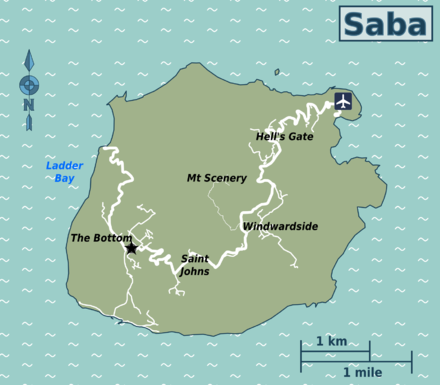
There are four small villages on Saba.
- The Bottom is the largest village and is the capital of the island. Despite its name, it is quite high up on the island.
- Windwardside – the second largest village and home to most of the shopping and tourist attractions in Saba. The regular sea breeze usually renders air-conditioning unnecessary, and makes it a nice choice for accommodation. Located between Hell's Gate and St. John's.
- Hell's Gate – the first village passed when traveling from the airport
- St. John's – the smallest village and largely residential. It does, however, contain both of the island's schools (primary and secondary), as well as a church and a couple eateries. It lies along the road between The Bottom and Windwardside.
Flora, fauna, and ecology

Over 60 species of birds inhabit the island, while over 200 kinds of fish swim near its shores. All of this diversity comes from Saba's unique ecology. The ocean surrounding the island goes from fairly shallow to very deep, with pinnacles scattered throughout. A fair portion of the island is considered rain forest, and Mount Scenery is home to a diverse range of climatic conditions in which an impressive variety of living organisms can thrive.
Be it lizards, aphids, sea life, or other creatures, Saba offers a level of diversity that seems impossible given the island's extremely small size.
Talk
The official language of Saba, is Dutch; however, English is the predominant language of Saba, and can be understood by most people.
Get in

Entry requirements
In general citizens of Western Hemisphere, European and "westernized" Asian and Oceanian countries may enter the island with just a passport and stay for 90 days.
Other visitors need a visa which has to be applied for at a Dutch embassy, costs €35, and is also valid for the other islands of the Caribbean Netherlands.
By plane
- Juancho E. Yrausquin Airport (IATA: SAB), 17.645556°, -63.220556°. Saba is a 15-minute plane ride from Saint Martin's Juliana International Airport, the regions largest airport with flights to the US and Europe. Winair is the airline used to get to and from Saba, and flights occur about 5 times a day (wind permitting).
 Opened in 1963, Saba's airport is a 400-metre (1,300-foot) length of runway sitting on Saba's biggest flat piece of land, a cliff-ringed promontory known as "Flat Point". Though it may appear dangerous, there have been no deadly crashes since the airport opened in 1963. The runway is marked with a large white X at each end signaling that it is not to be used by most commercial airplanes. In fact, pilots need special training to land here, and Winair is the only airline serving the airport, using the DHC-6 Twin Otter.
Opened in 1963, Saba's airport is a 400-metre (1,300-foot) length of runway sitting on Saba's biggest flat piece of land, a cliff-ringed promontory known as "Flat Point". Though it may appear dangerous, there have been no deadly crashes since the airport opened in 1963. The runway is marked with a large white X at each end signaling that it is not to be used by most commercial airplanes. In fact, pilots need special training to land here, and Winair is the only airline serving the airport, using the DHC-6 Twin Otter.
The danger comes from the airport's location in relation to the rest of the island. The side by which aircraft come in is flanked by a large cliff that the plane flies directly towards, before banking hard left, in order to line up with the runway. The airport is 18 meters (60 feet) above the ocean, and sheer cliffs on both sides of the runway lead to those rocky depths. There is a risk of an airplanes over-shooting the runway and falling into the ocean. A crosswind will cause airplanes to abort landings, as the rough turbulence can give even good pilots a hard time.
The airport's excellent safety record should put travelers at ease about this landing, which is undertaken 5 times daily. The airport is the shortest international runway in the world. The airport has a bar, no air-traffic-control station, and the airport manager is known by pilots for paying very close attention to every incoming flight, and if he rates a landing as a little too sloppy, he will most assuredly come out and complain to the pilot in no uncertain terms.
By boat
Two boats share the ferry service to and from Saba and St. Maarten: Dawn II and The Edge. As of 2015, both are featured on StMartinbookings where live availability and schedules for the two can be compared.
- Dawn II, +599-416-2299, sabactransport@gmail.com. Travels on Tuesdays, Thursdays and Saturdays. Check out the homepage for current schedule and rates. roundtrip 90 USD
- The Edge, 18.030975°, -63.094292°, +721 544 2640, +721 544 2631, info@stmaarten-activities.com. Travels between Saba and Saint Martin Wednesday through Sunday.
- Makana Ferry, info@sabaferry.com. Office located at the Captain Leo Chance Pier in Fort Bay. Travels between Saba and St. Martin as well as Saba and St. Eustatius Monday, Thursday, Saturday, and Sunday. 2022-09-15
Get around
The road
.jpg/440px-Josephus_Lambert_Hassel_Plaque_For_Building_%22The_Road%22_(6550004189).jpg) Josephus Lambert Hassell was the engineer who, in 1938, designed and supervised the building of the road from Fort Bay to The Bottom. Over the next 23 years, 14 km of road was painstakingly laid by hand and wheelbarrow by locals. It is said the men of Hell's Gate put in the most effort on the project because their village was the farthest away from Fort Bay. However, the creation of the airport later on Flat Point meant that the main point of arrival on Saba was now diametrically opposite: in the northeastern tip, rather than in the southwest.
Josephus Lambert Hassell was the engineer who, in 1938, designed and supervised the building of the road from Fort Bay to The Bottom. Over the next 23 years, 14 km of road was painstakingly laid by hand and wheelbarrow by locals. It is said the men of Hell's Gate put in the most effort on the project because their village was the farthest away from Fort Bay. However, the creation of the airport later on Flat Point meant that the main point of arrival on Saba was now diametrically opposite: in the northeastern tip, rather than in the southwest.
By taxi
Taxis can be called to travel from one town to another, and considering the treacherous nature of The Road (narrow, steep and often ringed with high stone walls), it is probably not wise to try to walk it. The taxi rates from town to town are strictly regulated, so, your likelihood of being hustled is slim. 2 people with 3 bags, airport to Windwardside: $15. Windwardside to The Bottom, 2 people: $10 (Jan 2011).
By car
There is a car rental place in The Bottom called Caja's Car Rental; however, you might want to pay attention to how the locals drive on the road before you decide you want to rent a car. Depending on the car, rental rates are $40-50 per day or $220-288 per week. There's just one gas station on Saba, located in Fort Bay and open M-F 09:00-14:00 and Sa 09:00-12:00 on Saturday. The traffic is on the right and speed limits are 20 km/h in the villages and 40 km/h outside them.
By foot
If you stay in Windwardside, you can walk to anywhere in Windwardside, and likewise for any of the other villages. But if you stay in one village and want to get to the next, it's probably best to just call a taxi or get a ride in some way. Some of the grocery stores will offer delivery service to where you stay, but be sure to ask if they offer this service before you start buying. Walking along The Road to the Bottom is not particularly pleasant, since traffic is fast and the road is narrow. A pleasant alternative, if somewhat steep, is the walking trail which leaves the Road at the Saba trail shop and meets up with it again directly uphill from the Medical School.
Hitchhiking
The people on Saba are very friendly, so hitchhiking from town to town isn't rare. Taxi drivers have even been known to pick up hitchers, not charging them for the ride if that's the direction they're going anyway.
See
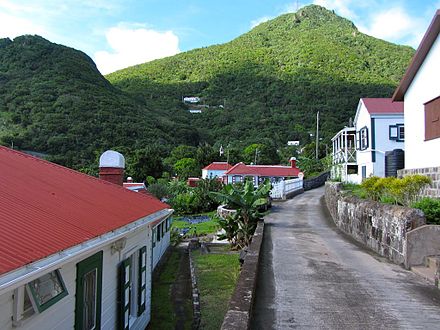
On land
- Mount Scenery, 17.635°, -63.239167°. With an altitude of 862m, Mount Scenery has the highest elevation in all of the Kingdom of the Netherlands. There is a hiking trail to go up the mountain that starts just outside Windwardside. It is best to hike up in the morning as the peak is often fogged in during the afternoon. 2019-01-10
- A road (not the Road) from Windwardside leads up to Booby Hill which has a few things to see. JoBean's Glass Studio is on that road, as well as a Guava tree orchard.
- Harry Luke Johnson Museum, 17.6278°, -63.2324°, +599 416 2231. M-F 10:00-12:00, 14:00-16:00. Built as a home for a Dutch captain in 1840, nowadays it is a museum with most of the original furniture and paraphernalia intact. Outside of it there's a bust of Simon Bolivar. $2
In the sea
Wall dives can be an almost humorous experience because the sea life that live along the wall may think that the wall itself is down, and orient themselves in that direction. Walls also offer lots of nooks and crannies in which sea life can live and hide, so you often see a wide variety of life on the wall.
The seabeds surrounding Saba are so diverse, that any level of diver can go there and have a good time. It doesn't matter if you're Open Water, Advanced Open Water, Nitrox, or whatever, the sea offers dives for you and the dive shops do their best to work with your wants.
Do
Diving
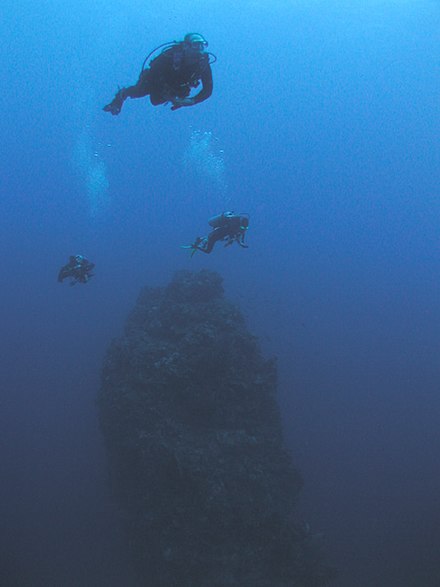 Saba is one of the top destinations in the world to go Scuba diving due to its sheer underwater cliffs, pinnacles, and the multitude of diving locations surrounding the island that each offer a unique experience. The people in the local dive shops are very friendly and great at teaching inexperienced people how to dive. They can take someone without their Open Water Certification and offer them a quick course and certification to get them in the water, or they can take them all the way into getting their Open Water Certification so they can dive without an instructor present. So even if you've never gone diving before, you can get certified in Saba.
Saba is one of the top destinations in the world to go Scuba diving due to its sheer underwater cliffs, pinnacles, and the multitude of diving locations surrounding the island that each offer a unique experience. The people in the local dive shops are very friendly and great at teaching inexperienced people how to dive. They can take someone without their Open Water Certification and offer them a quick course and certification to get them in the water, or they can take them all the way into getting their Open Water Certification so they can dive without an instructor present. So even if you've never gone diving before, you can get certified in Saba.
To protect the sea around the island, the "Saba Marine Park" has been established. There are 26 designated dive spots.
Diving companies
- Sea Saba Dive Center, Fort Bay, +599 416 3544, office@seasaba.com. Retail shop is in Windwardside. Dive office & workshop are in Fort Bay. 2022-09-15
- Saba Deep Dive Center, +599 416-3347.
- Saba Divers, Fort Bay, +599 416 2526, info@sabadivers.com. 2022-09-15
Hiking
.jpg/440px-Mount_Scenery_Trail_Steps_(6550016605).jpg) There are several official hiking routes, which were more frequently used by locals before there were cars on Saba. If you've forgotten to bring hiking gear, head to the Saba Trail Shop in Windwardside. They also offer guided hikes for $40.
There are several official hiking routes, which were more frequently used by locals before there were cars on Saba. If you've forgotten to bring hiking gear, head to the Saba Trail Shop in Windwardside. They also offer guided hikes for $40.
- Flat Point Track - 10 minutes, easy. The track is marked by color markers on the cliffs. You will see the ruins of a sugar factory and good views.
- The Ladder Track - 30 minutes, hard. 524 steps down to an old pier.
- Sulphur Mine Track - 20-30 minutes, medium. The path starts in Hell's Gate behind the church. The section leading to Mary's Point is not marked, so you might get lost. After Mary's Point there is a junction, take the path going downhill to the mine near Cave of Rum Bay.
- Sandy Cruz Track - 15-20 minutes, medium. This path starts above Hell's Gate, is marked by white markers and takes you into the jungle.
- Mount Scenery Track - 60-90 minutes, hard. A marked path with 1064 steps taking you up through the jungle to the peak of Mount Scenery. There are several huts and educative billboards along the path. If it is a clear morning you have a great view to the neighboring islands from the mountain top. For this hike you need shoes with rubber soles as the path is slippery.
- Maskerhorne Hill - 40 minutes, easy/medium. First, follow the Mount Scenery Track from Windwardside for about 10 minutes through dense jungle. After you've arrived at a small farm, turn left towards Maskerhorne Hill, from where there is a good view of Windwardside. Be aware that this path is quite narrow and dirty.
- Crispeen Track - 60-80 minutes, medium. This path begins at the outskirts of The Bottom. After a 15-20 minutes walk past fields along a pretty overgrown path you'll arrive at some buildings. From there continues a challenging path across a ridge through the jungle and fields. At the end you will arrive at the Mount Scenery Track.
Learn
Every October sees a month-long event put on by Sea & Learn: a non-profit foundation sponsoring events geared toward educating attendees about the flora and fauna of Saba and the surrounding waters. Nightly talks are given at local eating establishments by scientists from around the globe who also perform participative field experiments and/or nature surveys.
There is also a medical school on the island, attended primarily by American and Canadian students.
Buy
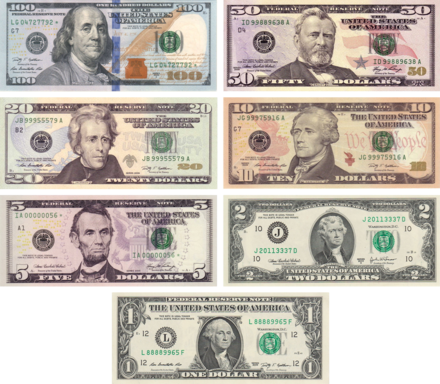
Money
Saba uses the U.S. dollar, denoted by the symbol "$" (ISO currency code: USD). It is divided into 100 cents.
There are two banks on Saba and they both have ATMs. Major credit cards and traveler's cheques are accepted on the island.
There is a 5% tax on rooms automatically added to your bill and 10% tax for service charge.
Souvenirs
.jpg/440px-Famous_Saba_Lace_Work_(6550012589).jpg) The famous Saban lace (aka pulled-thread work), introduced and developed by Saba's Gertrude Hassell, makes for an excellent souvenir. Local paintings and art also make unique souvenirs as they are created by the island's residents. Saba Spice, a sweet rum enhanced with local spices, is also another product worth acquiring.
The famous Saban lace (aka pulled-thread work), introduced and developed by Saba's Gertrude Hassell, makes for an excellent souvenir. Local paintings and art also make unique souvenirs as they are created by the island's residents. Saba Spice, a sweet rum enhanced with local spices, is also another product worth acquiring.
- Peanut Gallery, Windwardside (at Lambee's Place), +599 416 2509, tpgsaba@hotmail.com. M-Sa 09:00-18:00, Su 12:00-15:00. Paintings, prints, ceramics by artists on Saba and elsewhere in the Caribbean.
- Everyt'ings (formerly El Momo Folk Art), Windwardside (at Lambee's Place), +599 416 2518, info@etsaba.com. M-Sa 09:00-18:00, Su 12:00-15:00. T-shirts, handmade jewellery, local rum, art and greeting cards by Sabans.
- The Harry Luke Johnson Museum, Windwardside (near Lambee's Place). M-F 11:00-16:00 and upon request. Handmade lace by Sabans and Saba Spice is available at this 160-year-old Saban Sea Captain's Cottage.
- Jobeans Glass Designs, +599 416-2490. Glass art.
- Around the Bend, +599 416-2259. M-Sa 10:00-17:00, Su 11:00-15:00. Souvenirs, gifts.
- Katherine’s Windwardside Gallery, +599 416-2360. Art gallery.
- Ro Heilbron, +599 416-2881. Art gallery.
Eat
_(6550034153).jpg/440px-Coconut_Curry_Chicken_Stew_at_Scout's_Place_(Highly_recommended)_(6550034153).jpg) There are grocery stores in The Bottom and Windwardside in which travelers can pick up various snacks and food for meals if they want. Meals at restaurants typically cost between $15 and $35, so buying food at grocery stores can be a cheaper alternative.
There are grocery stores in The Bottom and Windwardside in which travelers can pick up various snacks and food for meals if they want. Meals at restaurants typically cost between $15 and $35, so buying food at grocery stores can be a cheaper alternative.
There are a lot of Guava trees, and even a few orchards, around the island. Locals have been known to share with visitors if asked nicely.
Groceries, including meat that isn't seafood, only comes in on Wednesday, and this leads to a few phenomena on the island. For instance, Wednesday is the best day of the week to get red meat (from a grocery store or a restaurant) and often the locals have parties at their homes where they grill out; they have been known to invite visitors. Additionally, with the exception of Wednesday, seafood will be the freshest food.
- Chinese Bar and Restaurant. Chinese Bar and Restaurant is one of two Chinese restaurants on the island (the other being in The Bottom). Get to it by taking a steep road next to Brigadoon all the way up and off to the right. The restaurant can't be missed as there is a large illuminated sign displaying its name. The food is decent enough, and price is around $12-18. It is run by an older Korean couple and their son.
- The Sea Witch (formerly Saba Treasure), +599 416-2819. Excellent pizza.
- Rainforest Restaurant, +599 416-3888. Its theme is to be one with nature, and you certainly feel that way while dining in candle light surrounded by the sounds and smells of the rain forest brought in by the fresh breeze. The taxi will drop you off about 200 metres from the restaurant itself where you will have to walk the remaining distance on a path. Bring a torch for the return trip. The menu changes nightly because they only serve what it is fresh that day.
- Brigadoon, +599 416-2380. W-M 18:30-21:30, Tu closed. Caribbean cuisine. Every Saturday night sees Sushi Night at Brigadoon, and this shouldn't be missed. Reservations are needed and must be entered by about 14:00 or so of the same day. They also sell Saba Rum which is vanilla and ginger infused rum, which is spectacular. Sit on the patio for the best atmosphere and enjoy the fresh flowers on the tables picked from Tricia's, the owner and cook's wife, garden.
- Scout's Place. A hotel, bar, restaurant, dive shop, and boutique. They serve breakfast, lunch and dinner: all are good and reasonable priced. Lunch is mostly burgers and sandwiches, where dinner adds in fish and fowl. There is also karaoke, called Sabaoke by the locals, on Friday nights. The deco is pirate themed and there is an open air deck that overlooks to the south. Breakfast pricing is about $8, lunch is about $15, and dinner is between $15 and $25 a person.
- Tropics Cafe, +599 416-2469. Daily 07:00-10:00, Tu-Su 11:00-15:00 and 18:30-20:30. Owned by the same people that own Juliana's Hotel, located next to Tropics. When open, one of the walls is collapsed so that all tables overlook the sea to the south. Breakfast, lunch, and dinner are served. Hamburgers and sandwiches for the rest of the day. Has a bar. Film nights every Friday. Prices are about the same as Scout's: $8 for breakfast, $10-15 for lunch, $15-25 for dinner
- Bottom Bean Cafe, +599 416 3385. M-F 07:00-17:00, Sa 08:00-15:00, Su 12:00-15:00. A smorgasbord of coffee and sandwiches, tacos and seafood.
- Bistro del Mar, +599 416-2498. Daily 07:30-09:00, Tu-Sa 12:00-15:00 and 17:30-late, Su brunch 09:00-14:00. Reservation preferred.
- Gate House Café, +599 416-2416. Open daily for lunch and dinner. Creole cuisine, reservation obligatory. starters $6-13, mains $17-29
Drink
There are a few bars on the island including, Guido's (in Windwardside), Lollipop's (just outside The Bottom towards Windwardside), and Swinging doors (in Windwardside). Again all of these places have the locals coming in at the end of the day, and its great way to absorb the local culture. Also the medical students on the island occasionally take time off from studying, so you may also meet them at the bars.
The beers in Saba are mostly Belgian and Caribbean/Mexican brews. Heineken, El Presidente, Carib, and Mackeson are the ones most common throughout.
- The Gate House. Has achieved Wine Spectator's Award of Excellence since 2002. Reservations are needed.
- Swinging Doors. Exclusively a bar except on Tuesday, Friday and Sunday nights: Tuesdays and Fridays are BBQ nights, Sundays are steak nights. Many locals hang out here throughout the week.
Sleep
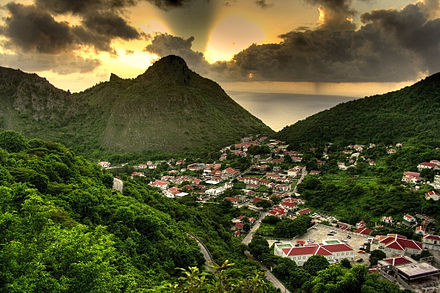
Budget
- Cranston’s Antique Inn, +599 416-3203. Has a restaurant, bar, pool and supermarket. Was renovated in the late 1990s. Single $30-45, double $45-60
- El Momo Cottages, +599 416-2265. Has about 8 cottages along a hillside on the Booby Hill Road. All cottages have a good view of the ocean and some of the views are spectacular. Some have attached baths and kitchens. The breakfast room is a great place to watch the sunset for the Green Flash, and the small swimming pool is a wonderful place to cool off after a hot hike. Single $40-90, double $65-105, breakfast $9
- Rainforest EcoLodges, Crispeen Trail (outside Windwardside, next to the jungle), +599 416 1454, info@saba-ecolodge.com. Rooms with occupancies for up to four people. Restaurant, bar, pool, art gallery but no TV or radio in the rooms. From $60-80
Mid-range
- Cottage Club, +599 416-2486. Located in Windwardside down the road next to the cemetery, taking the first left. There are 10 cottages for $65 or $85 a night (depending on the season). They look off to the North (so Saint Martin and Saint-Barthélemy can be seen on clear days), have kitchenettes with fridge and gas stove, 2 beds (queen and full), and no A/C (like most places in Saba) so windows must be left open at night to allow the cool night air in. Summer $105, winter $145
- Juliana's Hotel, +599 416-2269. Has intimate and informal atmosphere. Rooms have ocean and garden views.1 bedroom suites and Saban-styles cottages. From $120 2020-10-06
- Scout's Place, +599 416-2740. Has its own dive centre offers daily dive trips into the Saba Marine Park, the restaurant is open daily, and the terraces offer one of the best views on the island. The hotel is cozy with nice rooms, a separate Pirate Cottage, pool, tropical patio and free wireless internet. $79-130 in the summer, slightly more in the winter
Splurge
- Privately owned cottages There are quite a few privately owned cottages and houses on the island that have weekly rates throughout the year. The best way to find these places is to call the dive shops (Sea Saba, Saba Divers, and Saba Deep) who usually know about the cottages, pricing, and availability.
- Queen's Garden. Clings to a cliff above The Bottom. The suites, most with Jacuzzi, are spacious, and service is attentive. It's a bit out of the way but has a fine restaurant, and the staff will arrange taxis for tours and excursions. About $200 to $350 (plus 15% for service and tax) in season.
Stay safe
.jpg/440px-Windwardside_Police_Station_and_Immigration_Department_(6550028247).jpg) Saba offers a wide array of trails on which to hike, but know how good a hiker you are before choosing a trail. Some trails can be treacherous, and some hikes very difficult. If you don't go prepared to hike, stick to the easier paths. Beware of slippery moss, mud, and the occasional steep section. A walking stick is a tremendous help in making safe descents down the steep paths, particularly the trails leading to the coast.
Saba offers a wide array of trails on which to hike, but know how good a hiker you are before choosing a trail. Some trails can be treacherous, and some hikes very difficult. If you don't go prepared to hike, stick to the easier paths. Beware of slippery moss, mud, and the occasional steep section. A walking stick is a tremendous help in making safe descents down the steep paths, particularly the trails leading to the coast.
Saba is very safe. This is mainly due to the small population on the island which is exceptionally friendly to tourists as they are a primary source of income for the island. You can walk any part of the island at day or night without worry.
Saba is so safe that some hotels do not have locks on their doors.
The usual safety precautions are required while diving. A hyperbaric chamber is available at the Saba National Marine Park at the Fort Bay Harbour and is maintained by the Saba Conservation Foundation.
It is not recommended to enter into the sulphur mine (especially not alone), as the high concentrations of sulphur in the air can make you unconscious within seconds and a prompt rescue would be logistically impossible.
Stay healthy
On Saba the tap water is collected rain water. Most of the time it is safe to drink, ask the locals if it has to be boiled. There are canisters with spring water for sale in the supermarkets.
Go next
Saba can be very windy, and the small planes of Winair cannot always land there depending on the direction the wind is coming from. Check your flights; sometimes planning to leave Saba a day early and spending the night in St. Martin may be a good idea. The ferry boats which service the island offer an alternative if planes can't make it in or out.
There is a departure fee of $5 if going to another Caribbean Windward island or $20 if going to other destinations. It is payable only in USD.
Saba
sabagov.comSaba
Primary administrative division